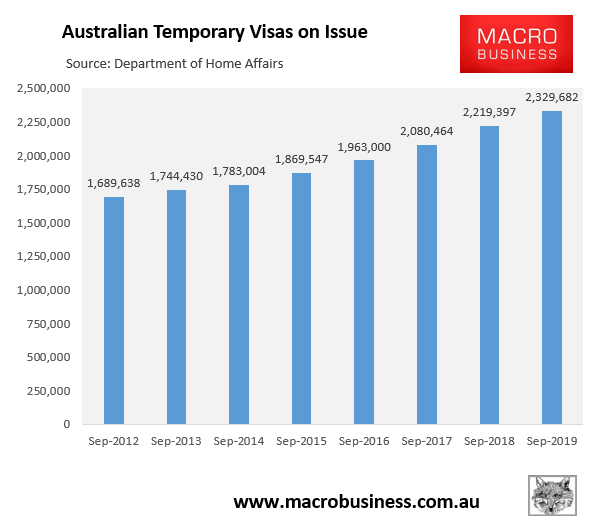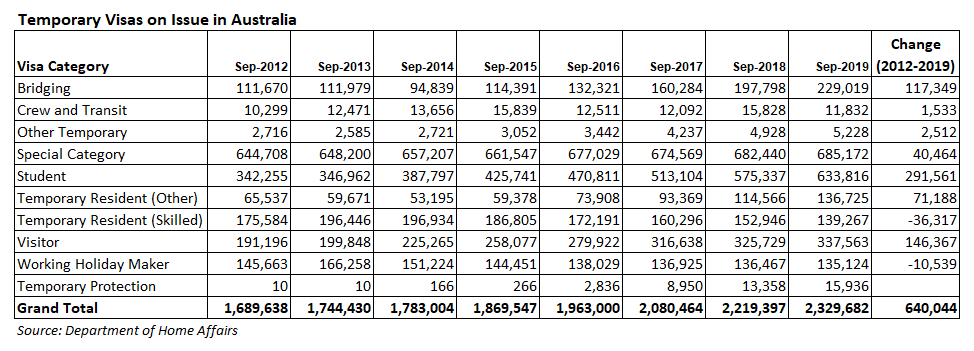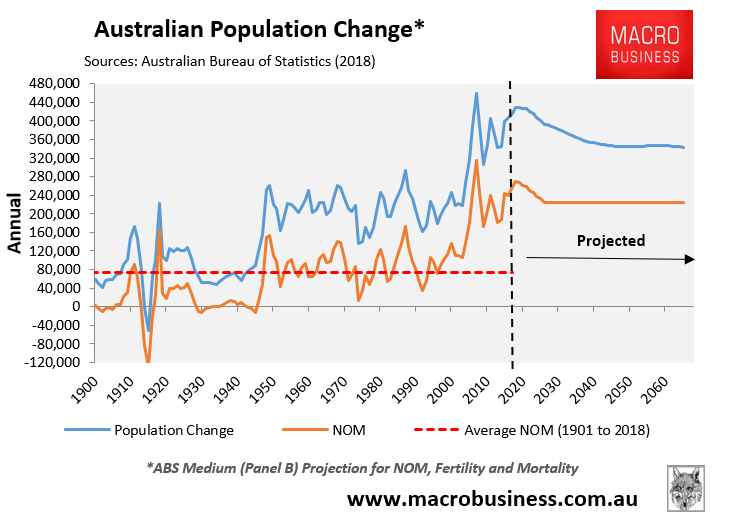Labor’s immigration spokesperson, Kristina Keneally, has taken direct aim at Australia’s ballooning temporary visa numbers, which have surpassed 2.3 million and are second only to the United States (see next chart).

Kristina Keneally wants these numbers reduced, arguing that the temporary migrant tsunami is crushing wages:
Australia currently hosts the second-highest number of temporary migrants in the world, second only to the United States…
Senator Keneally says temporary migration to Australia has been able to continue unchecked, with migrants being filtered into an “underpaid, under-class being used to cut wages and conditions across the country”.
“In the name of lower wages and cheap labour, this government is risking a new and damaging form of social and economic exclusion,” she will say.
According to Senator Kenneally, estimates suggest temporary migrants currently make up 10 per cent of Australia’s younger aged workforce.
“This is about whether we want to stop people working in Australia from putting down roots, raising a family, starting a business, creating ties with their neighbours through sport, volunteering, church or community,” she will argue.
“We understand the benefits of a well-regulated migration program – particularly for skilled workers – but do we, as Australians, as the people of the fair go, really want to create a society in which a growing proportion are permanently locked out of getting a go?”
Senator Keneally will also use the speech as an opportunity to put forward her plans for curbing the problem, including addressing wage theft, reliance on gig-based work and labour exploitation.
A breakdown of the temporary visa statistics shows that the largest contributor to this explosive growth is international students:

Labor is correct that all forms of temporary visas represent a massive labour supply shock that has lowered the bargaining power of local workers and placed downward pressure on wages. But what does it propose to do about it?
Is Labor prepared to crack down on the international student racket, including curbing their automatic work rights and closing the pathway to permanent residency, which are the primary incentives to study in Australia?
Is Labor prepared to significantly lift the $53,900 Temporary Skilled Migration Income Threshold (TSMIT) that applies to Temporary Skills Shortage (TSS) visas, which has been frozen in place since 2013-14, and has fallen $23,000 below the median full-time Australian salary of $76,900?
Will Labor restore integrity to the ‘skilled’ visa system by making all skilled migrants employer-sponsored and require them to be paid at the 80th percentile of earnings, or indexed to double the median wage? This would ensure that the skilled visa system is used sparingly to import only the ‘best of the best’, not as a general labour market scheme to undercut local workers.
These are the types of questions Labor must answer.
Finally, is Labor proposing to replace temporary visas with a larger intake of permanent migrants?
If so, this would be an even worse policy, given permanent migrants are the fundamental driver of Australia’s long-run population growth (since temporary migrants must eventually leave), and would create an even bigger Australia (and mega cities in Sydney and Melbourne).
Skilled permanent migrants are also appallingly low-paid and, therefore, are also undercutting local workers.
To truly make a difference to wages and living standards, Labor must abandon its globalist ‘open borders’ dogma in favour of deep cuts to immigration – both temporary and permanent.
Not only does this policy make perfect sense economically, but it would be very popular politically, given most opinion polls show a strong preference for lower levels of immigration and a stabilising population.
All Labor needs to argue is that it will slash immigration because:
- an excessive flow of migrant workers are displacing locals, reducing employment opportunities and lowering wage growth;
- excessive immigration is driving up demand for housing, pushing prices beyond the reach of locals, especially in Sydney and Melbourne; and
- excessive immigration is overrunning infrastructure and water supplies, reducing amenity and liveability, and pushing up the cost of living.
Most Australians know these to be true and would resonate with these common-sense arguments.
Moreover, Labor could argue that it is merely seeking to lower immigration back toward the historical (pre-2003) average, and that the new lower intake would still be at the higher end of developed nations:

If Labor is to maximise its chances of winning the next election, it must return to its working class roots and represent the interests of regular Australians over inner-city progressives.

